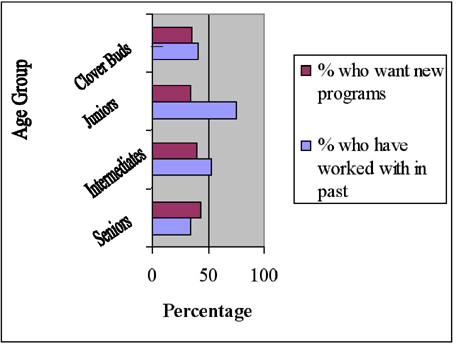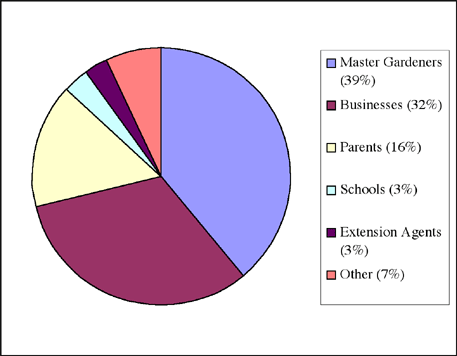August 2005 // Volume 43 // Number 4 // Research in Brief // 4RIB7
Implementing a Needs Assessment for Long-Term Strategic Planning in 4-H Horticulture Programming
Abstract
A needs assessment was implemented for
long-term strategic planning in 4-H horticulture programming. 4-H agents,
Agriculture and Natural Resource agents, and Master Gardener Coordinators
were surveyed regarding horticulture programs, areas for new programming,
and available resources and resource needs. Interviews were conducted with
staff of public gardens in Virginia indicating potential for programming
partnerships. Directors of 4-H camps expressed interest in curriculum modified
to their time constraints. Results identified areas for growth and needs
for improved communication and resource sharing. A Web site was developed
and new position recommended.
Introduction
Needs assessments are a critical element of effective Extension programming and one of the key components of Extension work. Information gathered from evaluations "is critical for documenting program impact, making changes for future programs, and identifying additional goals and objectives for future programming" (Severs Graham, Gamon, & Conklin, 1997).
To ensure that Virginia Cooperative Extension (VCE) is able to provide quality 4-H horticulture programming, a statewide needs assessment of the 4-H horticulture curriculum was conducted. Virginia Cooperative Extension (VCE) agents first started working with youth clubs in 1907, teaching boys to grown corn and girls to grow and can tomatoes. In 1920 these agricultural clubs became 4-H (Virginia 4-H, 4-H History). Over the years, 4-H has grown and diversified, expanding with programs in animal science, science and technology, and many other areas, while horticulture programs have fallen out of the main spotlight.
The number of youth educators using horticulture programs is on the rise with the awareness that many subject areas can be taught in a dynamic, hands-on way through horticulture. The constructivist learning theory claims that this type of hands-on learning is preferable to simple instruction (DeMarco, Relf, & McDaniel, 1999). Research has shown that children's attitudes towards nutrition (Lineberger, 1999) and the environment (Skelly & Zajicek, 1998) improved when they were involved in gardening projects.
Materials and Methods
A needs assessment was designed to determine the past usage of and satisfaction with VCE 4-H horticulture publications and measure plans for future use. Both written and phone interviews were conducted with 4-H agents, Natural Resources agents, Master Gardeners, and 4-H camp directors. The questions were written in a manner to allow the answers to be coded and entered into SPSS statistical software for easy analysis.
Questions for which respondents were asked to check all that applied asked which age groups and delivery modes respondents have used horticulture programs with in the past, which age groups and delivery modes most need new curriculum, what types of programs are desired, where resources have been obtained, and which resources were lacking. Demographic information, including role with Extension, years of service, and county of work, was collected.
The surveys went out by mail on November 2, 2001 to all 4-H agents, Master Gardener Coordinators, and other Agriculture and Natural Resources agents known to be working with Master Gardeners or youth (n=240). Surveys were collected through mid January. Each returned survey was coded with a number, and the data was entered into SPSS statistical software. The response frequency for each question was calculated, and cross-tabulations were used to compare answers of related questions.
From December 2001 through March of 2002, phone interviews were conducted with Virginia 4-H Camp directors. They were asked about their camps' past experiences with horticulture projects, their desire for future programs, available resources, and factors restricting their ability to offer horticulture programs. Also interviewed were staffs from the education departments of the arboreta and botanical gardens in the state. They were asked to describe their current horticulture programs for youth, to report any current or past collaboration with 4-H, and to list any needed resources as well as resources they had available to share.
Results and Discussion
Mailed Survey
The mailed survey had a response rate of 56% (n=135). Of those returned, 19 (14%) answered the demographic questions only, indicating that they had neither past experience with nor future interest in youth horticulture programming. Further information reported here is based on the 116 complete surveys, representing 67% of counties in Virginia, including both predominately rural and urban areas and large and small counties.
Audience and Delivery Modes.
The majority of past work focused on Junior (9-11 years of age) and Intermediate (12-13 years of age) age groups (Fig. 1). The age group worked with the least was Seniors (ages 14-18) while at the same time there were more requests for new curriculum for them. This suggests that a lack of age appropriate curriculum for the Senior age group may contribute to less work having been done with them.
Figure 1.
Past Work with Youth Horticulture
Programs Compared to Desire for New Programs for Each Age Group

The delivery modes most often used were school enrichment programs and community clubs (Figure 2). School enrichment programs had the highest request for new publications or programs, suggesting that this most popular delivery mode still has room for further growth (Figure 2). Summer camp had the second highest request rate.
Figure 2.
Past Delivery Modes for
Youth Horticulture Programs Compared to Desire for New Programs

Fifty percent or more of respondents indicated there was a need for career oriented, entrepreneurial, and demonstration type programs. The high request rate for these types of projects seems to reinforce the high reported need for Senior-level curriculum.
Resources
Survey respondents indicated that the highest level of resources or support (from volunteer time and expertise to plants and printed materials) used in the youth horticulture programs came from Master Gardeners (39%) and local businesses (32%) (Figure 3). Other major sources reported were parents, schools, and Extension agents. Sources lumped into an "other" category include local governments, grants, and fundraising.
Figure 3.
Resource Sources for Horticulture
Programs Used by Youth Educators

Respondents were also asked to list resources they most need VCE to develop (Table 1). The most highly requested resource was a list of available support materials, curriculum, and contacts. Making this information available would facilitate easy planning of horticulture programs. Other top requests were more coordination with Master Gardeners, new project books, agent training materials, and Power Point presentations. Also highly requested were computer games or programs and recognition/awards for youth participants.
|
Program Needs |
% Requesting |
|
Coordination with Resources |
|
|
Lists of Support Materials |
65 |
|
Coordination with Master Gardeners |
60 |
|
Communication Links to Share Resources |
37 |
|
Staff Training |
|
|
Agent Training Materials |
52 |
|
In-Service Training |
37 |
|
Electronic Resources and Multimedia |
|
|
Power Point Presentations |
51 |
|
Computer Programs/Games |
47 |
|
Web-based Interactive Instruction |
40 |
|
Videos |
37 |
|
Other |
|
|
New Project Books |
52 |
|
Recognition/Awards for Youth |
47 |
Interviews
4-H Camp Directors
To explore the potential for expanding horticulture to the camp programs as well as the other programming areas discussed, four of the six camp directors in Virginia were interviewed either over the phone or by e-mail. All of the 4-H Camp directors interviewed were interested in including horticulture programming at their camps. One director was a new employee and had no further information to share. The other three directors expressed similar difficulties in providing horticulture programming.
Their reported needs included funding to hire additional staff members to teach new curriculum, horticulture training for staff, and more coordination with Master Gardeners. None of the three had been well informed about what horticulture curricula were available. Further communication with the camp directors to describe what curricula are available and which ones would fit the time schedule of camp sessions would increase their ability to implement horticulture programming.
Arboreta and Botanical Gardens
Education staff members from three gardens in Virginia were interviewed. All three interviewed reported that they had never worked with 4-H and did not know what 4-H had to offer but that they were interested in finding ways to collaborate. A wide variety of children's programs and camps are already offered at each of these gardens. All three locations have plenty of resources to run their programs, but two of them voiced interest in obtaining more curriculum and activities from 4-H. From these interviews, it appears that potential exists for developing collaboration with resource rich gardens.
Conclusions and Implications
The use of a comprehensive needs assessment made it possible to target areas for growth to meet recognized needs and to develop a list of strategies to address these needs. This assessment of 4-H programs not only identifies needs and focus for Virginia's 4-H program, but serves as an example of a type of strategic planning tool that may be useful to other Extension programs. Periodic assessments can aid with long-range direction and program implementation and provide insight into current program utilization.
This assessment identified a need for growth and advancement in Virginia's 4-H horticulture programming, particularly for Intermediate- and Senior-level age groups. New information resources (electronic, publications, training materials, etc) can fill gaps in existing programming. Types of programming specifically needed are career oriented, entrepreneurial, and demonstrations. To be most cost effective, new publications should be made available on VCE's Intranet to be printed locally as needed.
In response to the request from 65% of survey respondents for a list of available support materials, a Web site has been designed to help agents find and understand horticulture topics and resources <http://www.ext.vt.edu/resources/4h/4hyouthhort/index.html>. Additional research would be beneficial to determine the Web site's efficacy in meeting 4-H horticulture curriculum needs.
Results from the survey and the interviews indicated that increased collaboration between VCE agents and Master Gardeners as well as with other horticulture agencies would enhance current horticulture programming. Other actions that require leadership at the state level that appear to be desired by field staff and volunteers include easier access to support materials, new project materials, teaching materials, and awards and recognitions for the youth. Creating communication lines to disseminate basic horticulture information would give leaders more confidence to sponsor programs.
Based on the identified needs from this survey and the lack of any staff or faculty position in the horticulture department to give leadership to this endeavor, it would appear that creating a 4-H Horticulture Coordinator position as an instructor level faculty or as a technical support person would facilitate many of these changes, including the generation of more collaboration, the production of new curriculum, and dissemination of information.
References
DeMarco, L., Relf, D., & McDaniel, A. (1999). Integrating gardening into the elementary school curriculum. HortTechnology 9(2):276-281
Lineberger, S. E. (1999). The effect of school gardens on the nutritional attitudes and behaviors regarding fruits and vegetables. M.S. Thesis, Texas A&M University, College Station.
Severs, B., Graham, D. Gamon, J. & Conklin, N. (1997). Education through Cooperative Extension. Delmar Publishers, Albany.
Skelly, S. M. & Zajeicek, J. M. (1998). The effect of an interdisciplinary garden program on the environmental attitudes of elementary school students. HortTechnology. 8:579-583.
Virginia 4-H. 4-H history. Retrieved March 3, 2005 from http://www.ext.vt.edu/resources/4h/about.html#history
